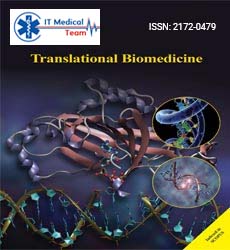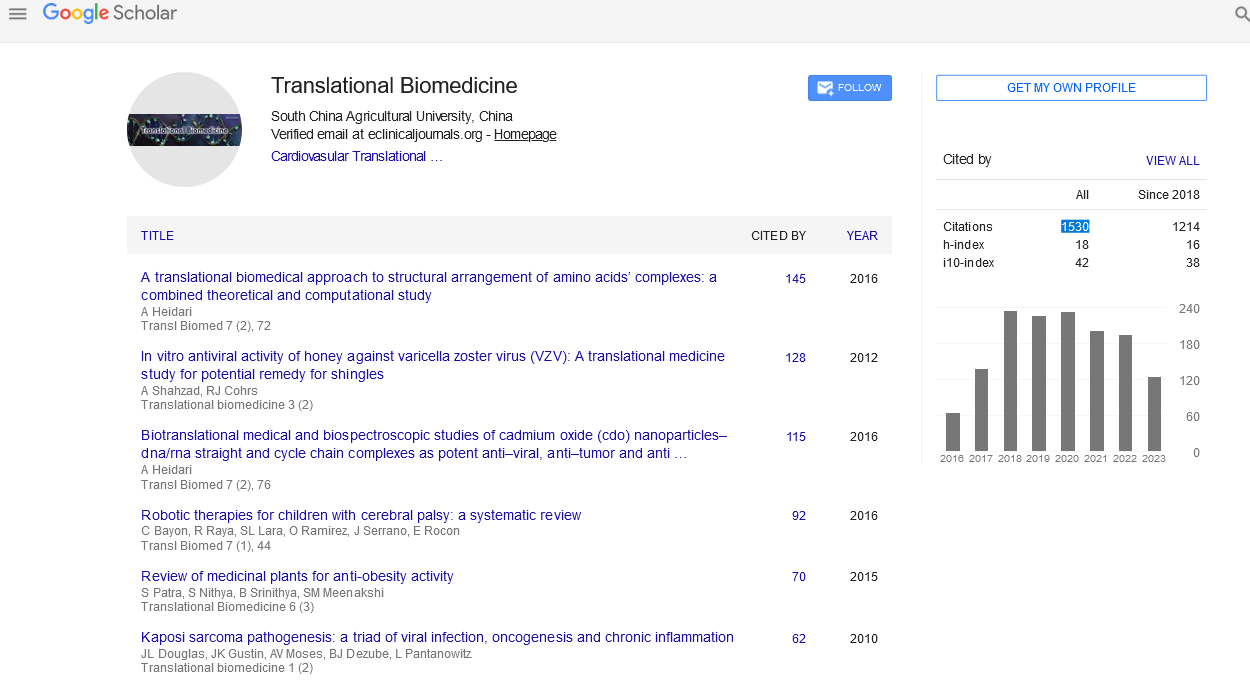Mini Review - (2023) Volume 14, Issue 3
Implementing Genomic Profiling: Opportunities and Obstacles for Academic Medicine
John Scott*
Department of Precision Medicine, Brazil
*Correspondence:
John Scott, Department of Precision Medicine,
Brazil,
Email:
Received: 01-Mar-2023, Manuscript No. Iptb-23-13607;
Editor assigned: 03-Mar-2023, Pre QC No. Iptb-23-13607 (PQ);
Reviewed: 16-Mar-2023, QC No. Iptb-23-13607;
Revised: 20-Mar-2023, Manuscript No. Iptb-23-13607 (R);
Published:
27-Mar-2023, DOI: 10.36648/2172- 0479.14.03.287
Abstract
The Baylor PGP's design and implementation are guided by the following guiding principles: high quality, robustness, low cost, adaptability, practical clinical utility, and the capacity to facilitate numerous areas of clinical research. The focus on extensive screening for rare disease-causing mutations rather than common risk�increasing polymorphisms is the approach's single most distinctive feature. The ability to screen for these variants at a low cost could have a significant impact on disease diagnosis, carrier detection, early detection of late-onset disease before symptoms appear, and even prenatal diagnosis. This system will not only create a counselling tool for individual "consumers," but it will also fit into the existing medical record and be used by doctors who provide direct patient care.
Introduction
In order to coordinate these efforts within the institution, BCM
joined the Personalized Medicine Coalition as an active member,
established an infrastructure for the Personalized Medicine
Alliance, and began planning a new graduate training curriculum
to educate the next generation of medical leaders [1]. A firstgeneration
Personal Genome Profile assay was developed by
BCM faculty members as part of this larger strategy to help
physicians in this new era of medicine diagnose and manage
patients. High quality, robustness, low cost, flexibility, practical
clinical utility, and the capacity to facilitate broad areas of clinical
research are the guiding principles of the Baylor PGP's design and
implementation. The prototype Personal Genomics’ tests were
narrowed down to specific Baylor Clinic and affiliated clinical and
translational research programs [2]. We include genetic tests
that are linked to individual responses to pharmacologic agents
and can assist in risk classification, like the majority of other
groups developing testing for personalized medicine. Rather than
focusing solely on common risk-increasing polymorphisms, our
strategy places an emphasis on comprehensive screening for
rare disease-causing mutations [3]. We are working on tools that
can be used to genotype a large number of rare mutant alleles
that are already known to cause genetic diseases. We believe
that the ability to screen for these variants at a low cost could
have a significant immediate impact on disease diagnosis, carrier detection, presymptomatic detection of late-onset disease, and
even prenatal diagnosis. We emphasize that our goal is not just to
develop a counselling tool for individual "consumers," but rather
to create a system that can be used by doctors who are involved in
direct patient care and fits into the established medical record [4].
Material and Methods
Common varieties modifiers of disease risk and
effects of Pharmacogenetics
The fact that for the first time epidemiologically robust and
statistically sound demonstrations of the effect of these common
variants on disease are available thanks to these studies has
been a tremendous success. The discovery of previously
unknown pathogenic mechanisms, which have the potential to
open up new avenues for drug and intervention development,
is a remarkable outcome. However, it is unclear how knowing
a person's specific variant pattern will affect them [5]. In a
recent study, Brautbar. show how incorporating a single genetic
variant into a well-established risk prediction model for coronary
artery disease could be used to decide whether or not to start
statin therapy in people with moderate risks. The general idea
that clinical decision algorithms can incorporate genetic tests
is very appealing. On the other hand, numerous concerns
regarding acceptability, cost, efficacy, and application are raised
by ambiguous assertions regarding lifestyle counselling based on genetic risks [6]. There are currently a few loci and genetic
variants that have been shown to have an impact on drug
metabolism or the risk of drug-induced toxicity, according to
convincing data. Individual differences in pharmacokinetics have
been linked to genetic variants that influence the absorption,
distribution, metabolism, and elimination (ADME) of various
drugs. Additionally, a number of genetic variants have been
linked to an increased risk of drug toxicities and side effects. The
entire issue of pharmacogenetics goes beyond the scope of this
brief commentary, but it is evident that only a small number of
such markers have significant effects and that only a few require
testing before they can be used in clinical practice. Despite this, we
are aware that one of the most significant diagnostic genotyping
applications is pharmacogenetics testing [7]. At least one
laboratory offered clinical pharmacogenetics testing for distinct
genes when our assay was designed. Studies with adequate
sample sizes, consistently defined effects on drug metabolism or
toxicity, independent repeated replication of the claimed genetic
effect, and clearly defined risk alleles or haplotypes only support
a subset of these, according to a review of the literature. Even
though we have included genetic analysis of all of these potential
genes in our version 1.0 assay, we only intend to notify referring
physicians about a select few established markers. The CYP2D9
and VKORC loci, which have been shown to have a significant
impact on warfarin metabolism, are two prime examples.
The justification for including mutations that
cause disorders of only one gene
Despite the fact that these conditions are uncommon on their
own, most doctors tend to dismiss them as zebras because of
their combined impact. Nearly 3,000 Mendelian disease-causing
human genes have been identified in the last two decades [8].
A job for a portion of these transformations is unequivocally
thought in more normal problems and demonstrated to be
risk factors in numerous illnesses in any case, until this point in
time, there has been no orderly examinations that address how
much uncommon changes add to normal sicknesses. There are
almost no single-gene disorders with a higher prevalence in
which the underlying genes have not been identified. There is
now population information regarding the mutant alleles that are
underlying the most significant of these diseases, either because
they are more prevalent or because they have a significant medical
impact. Numerous studies have been conducted on autosomal
recessive conditions like phenylketonuria and cystic fibrosis.
Familial bosom disease, an autosomal prevailing attribute whose
hereditary qualities include locus heterogeneity, age-subordinate
penetrance, and variable articulation, has been the object of
extremely huge scope DNA sequencing [9]. Numerous X-linked recessive disorders, particularly Factor IX deficiency, have been
extensively studied and offer a wealth of information regarding
human mutation mechanisms. Because most Mendelian diseases
are even rarer, these "classic" genetic diseases are unique in
some ways. The majority of the several thousand Mendelian
diseases have never been seen in more than one thousand
people, so there is a short list of mutations for those for which
a disease gene has been identified. There are some general
lessons that can be gleaned from all of the mutational data that
are available, regardless of whether the diseases in question have
a high prevalence or are extremely uncommon. Some disease
phenotypes are the result of the unique expression of just one or
very few alleles. Maybe the most sensational representation of
this component is the ways that of people with achrondroplastic
dwarfism bears the G380R transformation in the FGFR locus. The
structural characteristics of some disease genes make them more
susceptible to particular mutational mechanisms. For instance,
the dystrophic locus is very big and has intragenic low copy
repeat structures. These structures cause common deletions,
which together make up 70% of the mutant alleles. The most
common form of Charcot-Marie-Tooth disease is caused by
the duplication of a short chromosome region. Certain alleles
responsible for the most prevalent autosomal recessive diseases
have much higher frequencies than the average among all such
alleles due to demographic factors like migration, founder effects,
and possibly selection [10]. The fact that certain nucleotide
positions have intrinsic mutation rates that are higher than those
of the surrounding bases is yet another important consideration.
The T transition brought about by the deamination of methyl
cytosine is the one of these mechanisms that is best understood.
Triplet-repeat expansions are another special kind of mutation
that only affects certain loci and have a normal repeat structure
but a predisposing mutation. At last, changes in some nucleotide
positions are bound to prompt malicious amino corrosive
replacements in protein coding succession and subsequently are
bound to be destinations seen in people with Mendelian sickness.
Conclusion
High quality, robustness, low cost, flexibility, practical clinical
utility, and the ability to facilitate broad areas of clinical research
are the guiding principles of the first generation Personal
Genome Profile Baylor PGP assay. The emphasis placed on
extensive screening for rare disease-causing mutations rather
than common risk-increasing polymorphisms is the single most
distinctive aspect of its development. The ability to screen for
these variants at a low cost could have a significant impact on
disease diagnosis, carrier detection, early detection of late-onset
disease before symptoms appear, and even prenatal diagnosis.
References
- Kweekel D, Guchelaar HJ, Gelderblom H (2008) Clinical and pharmacogenetics factors associated with irinotecan toxicity. Cancer Treat Rev 34:656–669.
Indexed at, Google Scholar, Crossref
- Sahasranaman S, Howard D, Roy S (2008) Clinical pharmacology and pharmacogenetics of Thiopurine. Eur J Clin Pharmacol 64:753–67.
Indexed at, Google Scholar, Crossref
- Riepe FG, van Bemmelen MX, Cachat F, Plendl H, Gautschi I (2009) Revealing a subclinical salt–losing phenotype in heterozygous carriers of the novel S562P mutation in the alpha subunit of the epithelial sodium channel. Clin Endocrinol 70:252–258.
Indexed at, Google Scholar, Crossref
- Smirnov DA, Cheung VG (2008) ATM gene mutations result in both recessive and dominant expression phenotypes of genes and microRNAs. Am J Hum Genet 83:243–53.
Indexed at, Google Scholar, Crossref
- Houlden H, Groves M, Miedzybrodzka Z, Roper H, Willis T (2007) New mutations, genotype phenotype studies and manifesting carriers in giant axonal neuropathy. J Neurol Neurosurg Psychiatry 78:1267–1270.
Indexed at, Google Scholar, Crossref
- Qian J, Deveault C, Bagga R, Xie X, Slim R (2007) Women heterozygous for NALP7/NLRP7 mutations are at risk for reproductive wastage: report of two novel mutations. Hum Mutat. 28:741.
Indexed at, Google scholar, Crossref
- Wheeler DA, Srinivasan M, Egholm M, Shen Y, Chen L et al. (2008) The complete genome of an individual by massively parallel DNA sequencing. Nature 452:872–876.
Indexed at, Google Scholar, Crossref
- Maresso K, Broeckel U (2008) Genotyping platforms for mass–throughput genotyping with SNPs, including human genome–wide scans. Adv Genet 60:107–139.
Indexed at, Google Scholar, Crossref
- Grossman I (2009) ADME pharmacogenetics: current practices and future outlook. Expert Opin Drug Metab Toxicol 5:449–462.
Indexed at, Google Scholar, Crossref
- Brautbar A, Ballantyne CM, Lawson K, Nambi V, Chambless L et al. (2009) Impact of Adding a Single Allele in the 9p21 Locus to Traditional Risk Factors on Reclassification of Coronary Heart Disease Risk and Implications for Lipid–Modifying Therapy in the Atherosclerosis Risk in Communities Study. Circ Cardiovasc Genet 2:279–285.
Indexed at, Google Scholar, Crossref
Citation: Scott J (2023) Implementing Genomic Profiling: Opportunities and Obstacles for Academic Medicine. Transl Biomed, Vol. 14 No. 3: 112.





